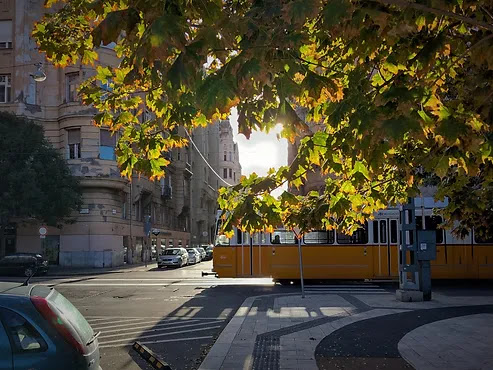Munich - Budapest
ÖBB Railjet RJX 65 - 654 km (7 hours)
Cost: €73.25
How could so much vomit come from a human so small? That was my first thought. My second was: Scheisse, now what? The night before we were to board our sleeper train to Romania - an epic 13 hour journey which we had been gearing towards for weeks - our youngest daughter began erupting like an Icelandic volcano. She wasn't the only one either. Shortly after it was J's turn and then our son joined in, soon a chorus of heaving and splashing rang through the house.
Fortunately we had kept our trip open ended for just such occasions. There would be no need for us to get up close and personal with the toilets on a Romanian long-distance train. The journey had to be postponed (seeyaw €180) and another apartment in Budapest sought out for the meantime. It was a shame we couldn't stay put. Our current abode was one of those rare finds on Airbnb which exceeds expectations. It was advertised as "minimalist", which I cynically took to be a fancy word for "barren". With three kids though, the fewer objects they could smash, smear or smite themselves on, the better. On arrival - after navigating the bus network from the glass roofed leviathan that is the Keleti train station, walking a couple of blocks through the laid-back bustle of a European city winding down in the evening and then following our self check-in instructions - we found the apartment to be clean, stylish and simple, yet well equipped.
Speaking of hot water, another draw card in Budapest is the natural thermal baths - some of which have been wrinkling toes since Roman times. I was keen to take the kids, but after some research found they were places better suited to wallowing as opposed to splashing and screaming which kids are prone to do when they so much as see a puddle. There are outdoor baths which have kids' pools and slides, but in mid-September, the weather was a bit bracing for that. In the end I was able to find a more suitable, if less historic alternative - the Aquaworld Aqua Park. The website promised "unforgettable entertainment" and an "ocean of adventure". As one of Europe's largest indoor water parks, I figured we would find some thing to suit us, so we hatched a plan. I would take the two older kids and Jenny would go with our youngest to explore the bohemian Jewish quarter.
With towels and togs packed, as well as a few snacks for the journey, we boarded a tram and travelled about an hour north. Passing through the communist era housing projects, we watched the locals board and alight toting shopping bags, briefcases or with reluctant kids in tow. Some of the older passengers would smile and gush at the kids, who (with nowhere to escape to this time) would look pleadingly to me for help. All I could do was wave my hands awkwardly and say "Sorry, we don't speak Hungarian". That didn't stop one woman sat opposite us, who continued to coo at the kids for about ten stops.
Eventually we arrived, paying the 11,000 forint (26 Euro) entry fee for the three of us for three hours. There were half a dozen pools of various depths and temperatures, with a selection of slides (most of which the kids were too short for). They were happy enough though, just splashing around, clambering over me and generally flailing about. My daughter even learned how to swim underwater - which was a family milestone to add to my son losing his first tooth a couple of days later, and my youngest daughter taking her first steps, all of which happened in Budapest.
Returning home red eyed and wrung out, we met J who was non-plussed about the Jewish quarter. She found it too commercialized, swarming with pouting tourists determined to enhance their social media profiles. Weirdly, it seems like we had a more genuine experience at Aquaworld (even if our photos weren't as good).
With more boxes ticked than we had ever planned, we were now ready to continue our journey east, the mystery of Transylvania awaited. That was until that evening, when my stomach began to gurgle like a defunct dishwasher. It seems it was my turn to be struck by the Buda-belly. As I lay bedridden, Jenny desperately searched once more for a new apartment. At least we hadn't booked our train tickets this time.
The next day saw another move, another two blocks, another step down in the accommodation ladder. Mercifully, the illness again passed quickly so after a couple more days of sightseeing, audiobooks, playgrounds and average sushi we were well and truly ready to go. Our destination was Brasov, one of the Siebenbürger - fortified Transylvanian towns settled by ethnic Germans in the first half of last millennium. For us it would be a chance to get a taste of the Carpathian wilderness, an untamed land where brown bears roam. An opportunity to stretch our legs and fill our lungs with fresh alpine air which, after a week of stomach bugs and apartment hopping in Budapest, would be just what the doctor ordered.

.png)

No comments:
Post a Comment